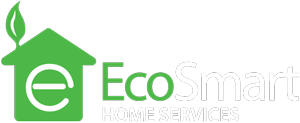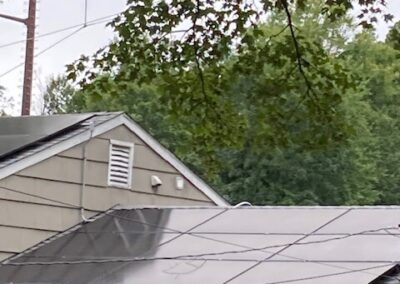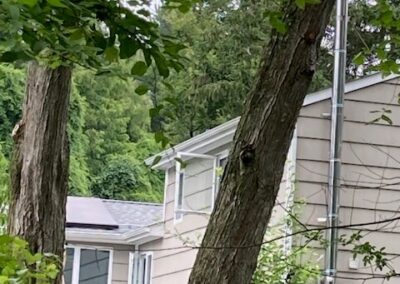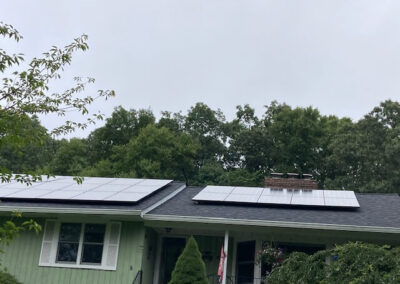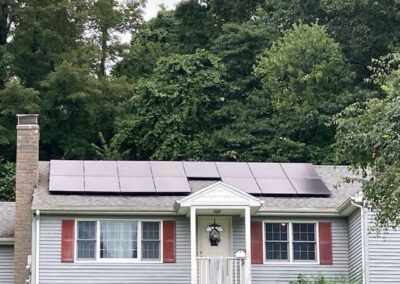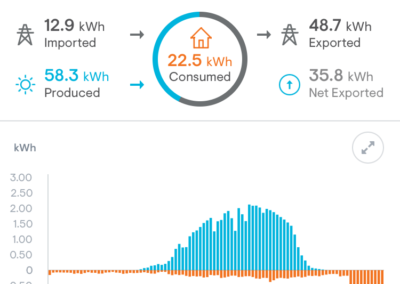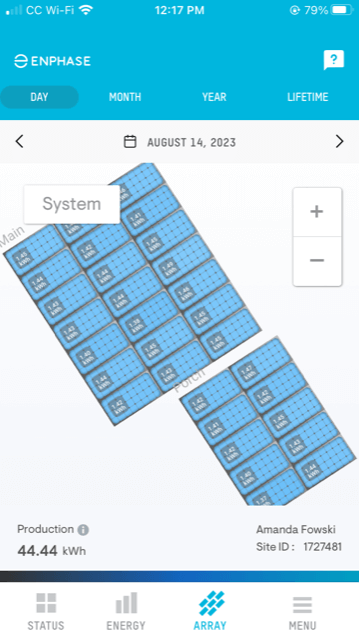Listen to Audio Version
Let’s talk about form and function with solar arrays. Do you ever drive by houses with solar panels and notice some are streamlined and sleek, with just pretty panels visible on the roof? While others are cumbersome-looking with panels and large metal conduit piping running across the roof and down the side of the house? There’s an explanation for that….
When installing a solar array, there are 2 basic types of systems. One is called a Central Inverter System, the other, a Micro Inverter System. They both have nearly identical performance ratios, and both have approximately 95% maximum efficiency. However, let’s break down the similarities and differences, as they are significant.
A Central Inverter System connects the solar panels on your roof in a string, or daisy chain, to a central location or central inverter. The inverter then takes the DC power produced by the panels (like the power in any battery) and changes it (inverts it) to AC power that your home can use. DC power is a more dangerous type of power (think Super-Charged!), which is why this type of application requires, via building codes, that it be run through large metal conduit. The inverter has a set input and output voltage and the panels are connected in “strings” when they are tied together and brought down to the central inverter, to turn the power into normal AC power your home can use. Each string has a maximum capacity, so when that max is reached, you’ll need to purchase another Central Inverter to accommodate more panels. Each panel has an optimizer under it to report production and to act as a rapid shutdown mechanism in the case of a power outage. Without these optimizers, the panels could be essentially super-charged, and be uber dangerous. Electric codes require they stop producing power in the event of an outage for the safety of the repair line crews.
The most popular company that makes central inverters with optimizers is called Solaredge. Their Central Inverter is warrantied for 12 years, though you can opt to purchase an extension, and their optimizers are warrantied for 25 years.
A Micro Inverter based system is relatively newer technology, compared to the Central Inverter system. A Micro Inverter system takes the DC power each panel creates, and changes (inverts) it to AC power directly at/under each panel, converting it to the same type of power you get from your electric company. Each panel has its own Micro Inverter, capable of producing 1.21 amps to 1.45 amps, depending on the panel. You can add the panels together in a daisy chain using a “trunk cable,” where the panel plugs into the Micro Inverter and the Micro Inverter plugs into the trunk cable. You can combine panels and Micro Inverters together until you reach a total of 16 amps, then you start a new string. Each string is then brought down to a central point called a combiner box, where it has a 20 amp dedicated breaker. All the power from the roof is combined and ready for use. Because it is already a safer form of power, and converted directly at the panel, there is no need for bulky metal conduits. The strings are wired like any other thing in your home, with normal Romex wiring that can be pulled through attics and walls, allowing for a more streamlined application, nicely hidden from view.
The market leader in Micro Inverters is Enphase. Their Micro Inverters are warrantied for 25 years.
Some notable similarities and differences between the two systems:
- Both systems have a disconnect for turning the entire system off.
- Both systems get connected to your main service panel.
- Both systems have an interface for reporting production and system failures, both on the internet and on your smartphone, should you choose to use the app.
- The average warranty of Central Inverters is 12 years, the optimizers, 25 years.
- The average warranty of Micro Inverters is 25 years.
- If a Central Inverter panel goes down, the entire array goes down.
- If a Micro Inverter panel goes down, only that panel is affected. The rest of the solar array continues production unaffected.
- A Central Inverter array is only as strong as its weakest link. If a panel is significantly shaded, the energy output of the entire system could drop by as much as 50%!
- A Micro Inverter array is unaffected by any individual panel. If one is shaded, only that panel will produce less. The remainder of the system continues to operate.
- Central Inverters require large, cumbersome, metal conduits be run along the roof and down the side of the house.
- Micro Inverters allow for standard Romex wiring to be hidden through attics and walls.
- If you like to follow your system’s production, like I do, with a Central Inverter system, you cannot see each individual panel’s production or output.
- With a Micro Inverter system, you can see each panel’s production and if a panel is not producing properly, it is easily identified.
- Expanding your solar array could be an expensive undertaking with a Central Inverter system, as the Inverter has a maximum capacity. Once you hit the max, you need to purchase another Central Inverter.
- Expanding your array with a Micro Inverter may be as easy as adding a few more panels, each with its own Micro Inverter attached, and tying them to an existing string.
- Central Inverters are a more dangerous type of power and panels can be super-charged with 700-1600 Volts of electricity.
- Micro Inverters are a safer form of power and produce 1.21-1.45 Amps.
EcoSmart Home Services chose to install the AC-based Micro Inverter systems when they began installing solar in 2012, due to the safety of the Micro Inverters and the ability to wire the system like any other electrical component in your home, with Romex wiring that can be hidden in walls and attics. They have installed both the Central Inverter and Micro Inverter systems and would be happy to install either on request. However, they are inclined to recommend, for a typical homeowner’s application, Enphase’s Micro Inverter system as they feel there are less points of failure, better and more consistent production, it allows for a more aesthetically pleasing finished look, and the interface, showing panel details and production, is helpful and fun!
I personally had EcoSmart install an Enphase Micro Inverter system on my roof. I absolutely LOVE the app, and literally check it daily, as I love seeing which panels are rocking production at any given hour on a nice sunny day! It’s become a little contest with myself to see if I can max out production compared to my consumption! Yup, the app shows me, in real-time, what my household is consuming vs what my solar array is producing… so cool! I also love that I can gauge if it makes sense to trim or remove a tree that might be over-shading an area. Or if a panel isn’t producing or working, I can see that instantly, as can EcoSmart, so any down time can be reduced significantly. I can even see, without stepping outside, which panels are covered in snow, and which ones have melted clear after a storm. Lastly, and this is just my personal preference, the large metal conduits required for the Central Inverter system are cumbersome-looking and unattractive. With my array being visible from the street, I’m happy I have the more streamlined and attractive Micro Inverter installation.
I hope you have gained some valuable insight as to the two types of systems and their pros and cons. Reach out to EcoSmart if you have any questions or if you’d like an assessment of your property’s suitability for a solar array.
Take time to soak up some sun!
